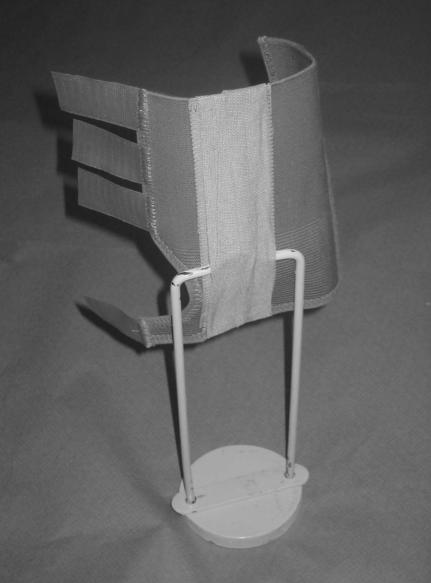BACKGROUND
The Stimson technique is well established for reducing anterior shoulder dislocations.1 It employs sedation or local anaesthesia to relax the shoulder muscles, and arm traction in shoulder-forward flexion to relocate the shoulder joint. This is usually applied by laying the patient prone with weights strapped to the arm hanging from the bed. With the addition of internal rotation of the scapula, high rates of reduction are achieved.2 Traction often relies on taping weights directly to the patient's arm using adhesive dressings.
TECHNIQUE
We constructed a novel traction device by combining a standard Futuro-type wrist splint with traction weights (Futuro brand; Beiersdorf, Hamburg, Germany). The metallic strut of the wrist splint provides a firm base onto which the weights are attached using strong fabric adhesive tape (Fig. 1). The device allows traction weights to be added or removed whilst in use. Traction does not rely on direct contact between skin and adhesive tape thus minimising the risk of skin damage through shearing force. If scapular manipulation is required to complete the shoulder reduction. a single operator can still perform this.
Figure 1.
(A) Assembly of traction weights, wrist splint and adhesive tape and (B) application of traction device.
DISCUSSION
All patients reported the device to be comfortable and none suffered adverse effects as a result of the device. The traction device was easy to apply, adjust and was readily constructed from materials available in the accident and emergency department.
References
- 1.Stimson LA. An easy method of reducing dislocations of the shoulder and hip. Med Record. 1900;57:356. [Google Scholar]
- 2.Miller SL, Cleeman E, Auerbach J, Flatow EL. Comparison of intra-articular lidocaine and intravenous sedation for reduction of shoulder dislocations: a randomized, prospective study. J Bone Joint Surg Am. 2002;84:2135–9. doi: 10.2106/00004623-200212000-00002. [DOI] [PubMed] [Google Scholar]




